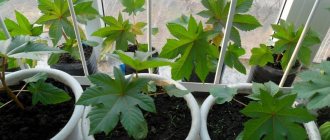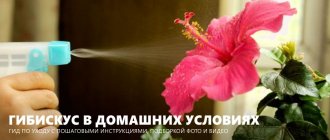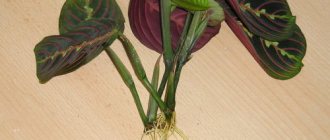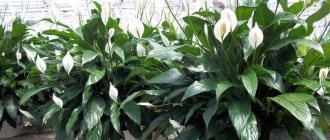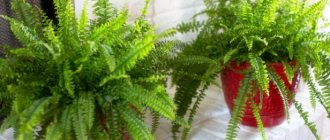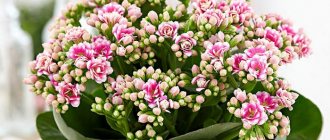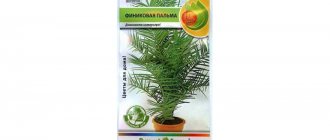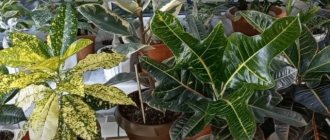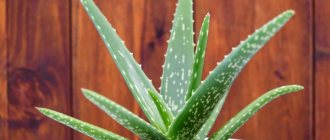Photo gallery
The plant is often mistaken for arrowroot, stromanta and calathea; it can be distinguished by its longer petioles and oval-elongated leaves.
Important! The plant is poisonous and poses a danger to children and pets.
Lighting is another challenge
This is the second point that those who want to grow their own ktenanta stumble over. Caring for a capricious beauty at home is complicated by the fact that you need to create a piece of tropical forest on your window. First, it would be good to imagine the conditions under which a flower grows in its natural environment. It has already been said that it should be warm and sunny. But the issue of lighting also needs to be resolved.
The plant is not too demanding in this regard. In nature, ctenants grow under the shade of large trees, so they do not suffer from a lack of sun. Moreover, direct sunlight is contraindicated for them. Dim, diffused light is best. But if there is not enough of it, then the new leaves will have shorter plates. Bushes will feel great in a northern or western room.
If the windows of your home face south, then the plant should be placed in the back of the room or shaded. Otherwise, the leaves may lose their bright color. But they will react in a similar way to a location that is too dark. It is especially important to shade the plant in spring and summer, when the sun's rays are especially bright.
Flowering and fruiting
The leaves are large, oval or oval-elongated, tapering towards the base, and arranged asymmetrically. Due to the short internodes, they seem to be collected in bunches.
In the evening the leaves close, rising up, and in the morning they fall. Thanks to the long petioles and large leaves, this process is accompanied by a characteristic rustling sound.
The main background of the leaves is bright or light green, with a clearly visible pattern of light green, yellow, gray or white stripes.
Small flowers of white-green, light pink, yellow or purple are collected in spikelet inflorescences pressed to the petioles.
At home it blooms extremely rarely.
Popular varieties
There are a large number of varieties of tropical flowers, so it is worth taking a closer look at those varieties that are best suited for planting in an apartment on a windowsill.
Ktenanta Oppenheim
Bromeliad - home care, watering and propagation
Ktenanta Oppenheim creates a minimum of problems when cared for at home. It is often chosen by those who do not like to spend a lot of time caring for flowers. Oppenheim's ctenanta is a fairly tall species, growing in a pot up to 120 cm, in nature - up to almost 2 meters. The leaves of this variety are characterized by a lanceolate shape. They grow up to 20 or 30 cm in length. The foliage color of Oppenheim's calathea is alternating grayish-green and gray stripes.
Ktenanta Lubbersa
Ktenanta Lubbersa is another optimal variety for the windowsill. It is very easy to care for. The description of the variety is as follows: plant height - from 80 to 100 cm, leaves are oblong, dark green on top, pale green at the bottom with variegated veins.
Ctenanta Amagris
Many people know Ctenanta Amagris. This herbaceous perennial has oval oblong leaves, the length of which ranges from 15 to 25 centimeters. Their color is silver-green, very light, with thin stripes of a dark green hue along the veins. Another feature of the Amagris leaf is the burgundy tint of its lower part. Everything together looks very impressive and original.
Ctenanta pubescent
Among the ctenanta flowers of different species, the pubescent ctenanta is considered the most capricious. The plant is especially picky about air humidity, temperature and drafts. The flower looks very interesting. It has dark green, egg-shaped leaves with light green stripes. The latter look as if they were painted with paint using a brush. The pubescent variety grows up to 80 centimeters in height.
Ctenanta compressed
Another interesting variety that often finds a place on window sills is Calathea ctenanta compresses. This species grows to an average height of 90 cm. Features of Ctenantha compressa include glossy oval-shaped leaves, the length of which can reach 30 cm. They are usually located on high basal carts. The leaf blades are entire-edged and have a rich dark green hue.
Ktenanta Burle Maxi
Many people know Ktenanta Burle Maxi as the smallest plant in the family (up to 20 cm), which is characterized by very original colored leaves. The foliage itself is thick, almost rectangular in shape with wide dark stripes and a dark purple underside. In nature, Burle Maxi forms an almost continuous carpet consisting of bright leaves, the length of which is 10 cm, width - 5 cm.
Ctenanta Setosa
Ctenanta Setosa has elongated, dark green, ovoid leaves. The longitudinal stripes located on them are most often painted in a bluish or light green shade. The height of the plant can reach 80-90 centimeters. The perennial feels quite comfortable as a houseplant and does not require special conditions for successful cultivation.
Ktenanta Tricolor
The main feature of Ctenanta Tricolor is (as the name suggests) tricolor leaves. It is a hybrid of the Oppenheim variety, with striped yellow-green leaves and a bright purple underside. Externally, the flower resembles one of the Stromanth varieties.
Important! Ctenanta is a poisonous flower. It is not recommended to grow it in houses where pets live.
Signs and superstitions
Ktenanta is the protector of the family hearth. Being in the spouses' bedroom helps strengthen family ties; in the children's room it helps a restless child calm down and find inner balance.
Helps get rid of fatigue and stress, create a calm atmosphere, find peace and understanding in the family.
According to Feng Shui, this is a plant with masculine Yin energy. It is recommended to place it in the work area, a teenager’s room, or a place where cheerful and noisy groups gather.
Helps avoid conflict situations, protects household members from illness, and eliminates negative energy.
Microclimate
As a true inhabitant of the tropics, the comb flower places very high demands on temperature, lighting and humidity. If these conditions are not met, the plant can easily be lost, so you need to worry about them in advance.
Location
When choosing a place for a crocodile leaf, you need to take into account the characteristics of the growth of this flower in nature. There, the ctenanta prefers to hide in the shade of tall trees, while constantly being in a very humid and warm environment, characteristic of the tropics. Thus, in indoor conditions, the flower will be equally uncomfortable both at the southern and northern windows: in the first case, too bright sun and dry air play a negative role, in the second, on the contrary, a lack of light and heat. From this point of view, it is optimal to place the pot near the eastern or western windows. If this is not possible, on the south side the flower will need to be removed away from the window, and on the north side it will need to be additionally illuminated.
Important! You can’t place ktenanta next to heating devices, as they dry out the air very much, and this factor is detrimental to a tropical plant.
Lighting
In summer, direct sunlight poses the greatest danger to the crocodile leaf. In general, the plant is shade-loving, so it feels quite comfortable in partial shade. However, in winter, when the number of clear days in the middle zone sharply decreases, the flower begins to experience a lack of light and heat. Based on these rules, lighting should be varied wisely depending on the season. The condition of the decorative leaves will tell you how correctly this condition is met: their size decreases and the brightness of the color is lost in cases of excess light; when there is insufficient light, the leaf blade becomes lethargic.
Temperature
The comb flower is not as demanding on the temperature regime as it is on other climatic conditions, however, it is very important for the plant that these parameters are constant: the flower does not like sudden changes in temperature, including day and night. The crocodile leaf feels best when the soil temperature is in the range of +18...+22 ºC, air temperature - +22...+25 ºC. It is advisable not to allow the room to cool below +18 °C; the critical indicator at which the plant can no longer develop normally is a cold snap to +16 °C
It is advisable not to allow the room to cool below +18 °C; the critical indicator at which the plant can no longer develop normally is a cold snap to +16 °C
The crocodile leaf feels best when the soil temperature is in the range of +18...+22 ºC, air temperature - +22...+25 ºC. It is advisable not to allow the room to cool below +18 °C; the critical indicator at which the plant can no longer develop normally is a cold snap to +16 °C.
Air humidity
At home, the most difficult thing is to provide the ctenant with sufficient air humidity. The plant needs an indicator of at least 70%, preferably up to 90%, which is almost impossible to achieve in residential premises.
Did you know? In the evening, the leaves of the ctenanthus gather at the base, and with the first rays of the sun they bloom again: thus, a rustle is created from them, and it seems that they come to life.
Some gardeners place ctenanta in decorative florariums, aquariums or terrariums, where it is much easier to create a suitable microclimate for the plant.
Home care
Temperature and humidity
For normal growth and development of the ctenant, the air temperature in spring and summer should be +22-25 °C, in winter – +16-20 °C.
Due to hypothermia of the roots, the plant may die, so it is important to monitor the soil temperature, the optimal value is +20-22 °C.
Throughout the year, the humidity level should not fall below 70-80%; for this it is necessary to spray the plant and the air around it several times a day, use a humidifier, pour wet expanded clay into a tray, and cover the color with a plastic bag at night.
Lighting and comfortable place
Variegated varieties of ctenantha need diffused light; species with monochromatic leaves feel comfortable in partial shade.
Important! With an excess of bright light and under the influence of sunlight, the leaves of the plant fade.
Daylight should last at least 12-14 hours, and in winter additional artificial lighting will be required.
It is best to place the plant on the windowsill of a western or eastern window.
Shade tolerance
Shade tolerance depends on the leaves: the darker they are, the less light required. However, with a prolonged lack of light, the foliage will lose its brightness and the plant will stop growing.
Trimming
With uncontrolled growth, the ctenant loses its decorative effect: new shoots are too weak, due to lack of space, the leaves become small and turn yellow.
It is necessary to promptly and regularly remove long shoots and trim off limp and dried leaves, the place of which will be taken by new ones.
Care during the rest period
For growth and development, the ctenant does not need a pronounced period of rest. In order for her to rest enough in winter, lower the air temperature, reduce watering and fertilizing. Lighting requirements remain the same.
Common mistakes made by amateur gardeners
The ctenant reacts to any mistakes in care or unsatisfactory living conditions by deteriorating her appearance. And since its main value in the eyes of a gardener is its bright, variegated foliage, you need to learn to correctly interpret the signals sent by the plant in order to know what exactly it doesn’t like.
Table: how the client reacts to errors in care
| What does the plant look like? | What is the reason? |
| The stems lose their tone and droop. Ctenanta grows slowly. | Temperature too high. |
| The leaves curl into a tube and become covered with brownish spots. | Moisture deficiency. This applies to both watering and spraying. |
| The leaves change color to yellow-brown. | Deficiency or, conversely, excess of nutrients in the soil. |
| The leaves fade, dry out, and the variegated color disappears. | The lighting is too bright. |
| The leaves fall without drying out. | Low air humidity or too much watering. Or the plant is in a draft. |
| The bases of the stems and leaf petioles turn black. | Low temperature combined with high humidity. |
Curled leaves of the ctenantha indicate that the plant suffers from moisture deficiency
What kind of pot do you need?
The pot needs to be wide and not very high; during replanting, the new container should be 3-4 cm larger than the previous one. In a pot that is too spacious, water will accumulate, which will lead to the development of root rot.
The most suitable material is ceramics, due to the porosity of which it is easier to avoid waterlogging.
The flowerpot must have drainage holes. Walnut or eggshells, small pebbles, crushed stone, expanded clay, and tree bark are suitable for drainage.
Diseases and pests affecting the ctenant
A florist growing a plant will have to deal with the most common pests that feed on plant sap. Another serious danger threatening the plant is root rot. Here, most often the owner himself is to blame for watering it too much.
In general, with proper care, the ctenant rarely suffers from diseases and pests. The risk of infection can be minimized by performing a set of simple preventive measures:
- quarantine for new acquisitions for 3–4 weeks;
- inspection of plants for the presence of suspicious symptoms and immediate isolation of those specimens in which they are detected (at least once every 5–7 days);
- free placement of pots on the windowsill without crowding;
- regular ventilation of the room;
- placing indoor flowers and bouquets as far as possible from each other (preferably even in different rooms);
- proper watering and maintaining high humidity;
- wiping dust from plant leaves and sanitary pruning;
- using only sterilized soil, clean pots and tools;
- periodically replacing the water for irrigation with a pale pink solution of potassium permanganate, weekly irradiation of the leaves on both sides with a quartz lamp (2-3 minutes is enough).
Table: diseases and pests typical for ctenants
| Disease or pest | External manifestations | Control measures |
| Root rot | The bases of the stems and petioles turn black, the leaves become covered with brown spots. Mold appears on the soil and gives off an unpleasant putrid odor. | You can get rid of root rot only if the disease is detected at an early stage of development.
|
| Mealybug | Spots of whitish coating - the plant seems to be dusted with flour. The leaves quickly turn yellow and dry out. |
For prevention, once every 12–15 days, spot-apply any preparations containing Neem tree oil to the leaves. |
| Spider mite | Translucent cobwebs entwine the petioles and stems. On the underside of the leaves there are small brown dots and vague yellowish spots around them. |
For prevention, spray the plant weekly with a decoction of cyclamen tubers. |
| Shchitovka | Gray-brown round growths on stems and leaves. They quickly “swell” and the tissue around them turns yellow or red. |
|
| Whitefly | Small whitish butterflies flutter from the flower whenever you touch it. |
|
| Aphid | Small greenish-yellow or black-brown insects cling to the underside of young leaves. |
|
Photo: diseases and pests that you will have to fight when growing ctenanta
Aphids are a surprisingly “omnivorous” pest; ctenanta is also among its interests
The whitefly has an inexplicable weakness for the color yellow - this feature can be used in the manufacture of homemade traps
The durable shell reliably protects the scale insect from most folk remedies; the fight must begin immediately with the use of insecticides
Spider mites are not insects, so special preparations are used to combat them - acaricides
Leaves infected with mealybugs turn yellow and dry out very quickly.
Root rot is a dangerous fungal disease; a plant can be cured only in the early stages of its development.
Where can I buy it? Price range
Ktenanta is sold in online and offline flower shops, the cost depends on the size of the flowerpot, height and type of plant and averages 500 rubles. — 10 thousand rubles.
What to do after purchase?
A newly purchased plant should be given about 10-15 days to acclimatize. Replanting is required only in the case of a very overgrown root system.
Using fertilizers for Oppenheim's plant
Caring for a tropical flower at home must be complete to ensure that your plant is healthy and beautiful. We talked about external influences. But the roots of the plant are in the soil, which means you need to pay attention to this important factor. We already said above that the soil should be moist, but not wet. But this is not all the requirements.
The soil should be loose, slightly acidic and consist mostly of leafy parts. It is very important to add peat, charcoal, humus and pine soil to it. Coarse sand will make the substrate more crumbly. You can do a little experiment. Take a handful of soil and squeeze. If after this the composition crumbles freely, then it is suitable for planting.
Potted plants are severely limited in their ability to obtain nutrients. In nature, they are renewed naturally, through decay of leaves and insects. And the roots of the plant can grow to the sides. In the pot, the plant only has what you give it. Therefore, it is necessary to regularly replenish the supply of nutrients, as well as change the soil.
What kind of soil is needed?
The soil must be nutritious, loose, moisture- and breathable, and have low acidity (pH up to 6.0).
You can use ready-made store-bought soil intended for arrowroot or azaleas, having previously enriched it with charcoal, or prepare it yourself by mixing:
- 1 part sand;
- 1 part peat;
- 2 parts leaf soil.
It is important to ensure that the substrate does not contain lime and spill it with a solution of manganese or treat it thermally to get rid of pests.
Expert opinion
Mokhov Andrey Petrovich
Graduated from KubSAU, specialty: agronomy
Before planting the ctenant, the soil must be checked: if, after squeezing in a fist, it remains free-flowing, you can begin replanting.
About caring for Ktenanta:
Temperature: The optimal temperature for Ktenanta in summer is 22-25 ºC, and in winter the temperature should not fall below 16 ºC. There should not be a strong difference in temperature between night and day. Ktenanta is a heat-loving plant, but it is not recommended to place the plant next to radiators or heaters in winter. In summer, the plant may suffer from the cold air flows of the air conditioner, so it should not be placed under air conditioners or in critical proximity to them. The plant is afraid of drafts and hypothermia of the root system. In the summer, the ctenant can be taken out onto the balcony or terrace, but it must be protected from direct sunlight, wind and precipitation.
Lighting: Ktenanta needs diffused lighting. An eastern or western window sill is suitable for it; it also develops well on a northern window, since the plant does not require lighting and is considered shade-tolerant. When kept in a room with a southern orientation, it is recommended to find a place for it on a table next to the window.
Ctenanthe oppenheimiana.
Watering: Should be regular and plentiful. It is necessary to water with warm, soft, settled water. The frequency of watering depends on the temperature of the content. In summer, watering should be carried out as soon as the top layer of soil dries out. At the same time, in summer, on hot sunny days, you need to water more often, and in cold and cloudy weather - less often. In winter, watering is reduced, but you should not let the substrate dry out completely. The water from the pan must be drained after watering. Excess water in the soil can cause root rot.
Air humidity: Ctenanta is demanding of air humidity and its daily procedure should be to spray the leaves with soft, settled water in the morning and evening, especially if the plant is kept in a room with dry air. In order to increase humidity, you can use pallets with wet expanded clay. In this case, the bottom of the pot should not touch the water. It is necessary to clean the leaves from dust and periodically give the plant a shower, but make sure that after the shower the drops do not remain on the foliage.
Fertilizers: It is necessary to fertilize in spring and summer once a month, and in winter, watering can be reduced to once every 2 months. Fertilizers must be applied in half the dose, since the plant is very sensitive to fertilizers. Next, complex fertilizers for decorative deciduous plants are used for feeding.
Ctenanthe lubbersiana.
Soil: Soil for decorative foliage plants, a universal substrate, is suitable for Ktenanta. You can use special soil for Marantaceae. It is advisable to add charcoal, perlite, coconut soil and humus. Good drainage at the bottom of the pot is necessary.
Transplantation: It is necessary to replant once a year in order to accelerate the development of the plant, and for adults only once every 3 years using the transshipment method. The pot should be wide and not deep and 1-2 cm larger than the previous one. When transplanting, it is recommended to wrap the roots of the plant with sphagnum moss. After transplantation, the plant is not fertilized for a month. If replanting is not carried out, it is recommended to replace the top layer by adding fresh substrate.
Pests Ktenanta. Damaged by spider mites and scale insects.
Reproduction
Ctenanta is propagated by cuttings, dividing the bush and seeds.
For reproduction you will need:
- soil mixture;
- water;
- flowerpot;
- growth stimulants – “Zircon”, “Epin”, “Kornevin”;
- knife;
- charcoal or cinnamon;
- polyethylene.
By cuttings
For cuttings you need:
- cut branches 8-10 cm long, each cutting should have 1-2 internodes and 2-3 leaves;
- treat the sections with crushed or activated carbon and dip in a solution of “Epin”, “Zircon” or “Kornevin”;
- place the cuttings in a container with water;
- when the roots grow to 0.5-1 cm, transplant into soil, spray and cover with polyethylene to create a greenhouse effect;
- place the greenhouse in a room with bright, diffused lighting and a temperature of +22-25 °C;
- regularly ventilate the greenhouse and water the seedlings;
- After the leaves appear, remove the greenhouse and care for the seedlings as if they were an adult plant.
Reference! Cuttings should be harvested in late spring or early summer.
Dividing the bush
During transplantation, it is necessary to cut the roots into several parts with a sharp sterile knife so that each has several leaves and a developed section of root.
Sprinkle the sections with crushed charcoal or cinnamon powder and dry for several hours.
Place the cuttings in separate containers, spray and cover with polyethylene. As the soil dries, water with a weak solution of a growth stimulator - “Epin” or “Kornevin”.
To speed up the rooting process, it is necessary to provide bright lighting, a temperature of +25-27 °C and use bottom heating. In this way, only large and completely healthy plants over 5 years old can be propagated.
Seeds
Ctenanta is extremely rarely grown from seeds due to the difficulty of obtaining them at home.
To germinate seeds, it is necessary to keep them in greenhouse conditions in constant humidity, in bright light and at a temperature of at least +20 °C, using bottom heating.
Entrances appear after a month, after another 30-40 days they can be planted in separate containers.
Transplant procedure and preparation for it
For females under the age of five years, transplantation is an annual procedure. Adult specimens are moved to a new pot less often - every 2-3 years. At the same time, they change the top 2–3 cm of soil annually. The best time for the procedure is late spring or early summer.
The container is wide and shallow, similar to a bowl. Each time its diameter is increased by 5–7 cm. The best material is unglazed ceramics, in which the soil sours much less often.
The soil required is sufficiently nutritious, but at the same time well-permeable to air and water, and slightly acidic. A special mixture for Marantaceae is rarely found on sale, so it is prepared independently from leaf soil, peat chips, coarse river sand (2:1:1) and pieces of charcoal, finely chopped sphagnum moss (approximately 5% of the total volume of the mixture). An alternative is commercial azalea substrate.
Soil for arrowroot is rarely found on sale, but it can be replaced with a self-prepared mixture, all components of which are quite accessible
The transplant itself looks like this:
- Pour expanded clay or pebbles into the new pot (layer 2–3 cm thick). On top there is about the same amount of fresh soil.
- Remove the ctenanta from the old container. This is easier to do if you water the plant generously about half an hour beforehand. Try to keep the earthen ball intact.
- Trim dried leaves. Do the same with dead and/or rotten roots. Sprinkle the “wounds” with crushed chalk, activated carbon, and cinnamon.
- Place the earthen ball in a new pot, add substrate around the edges. When finished, gently shake the container to fill any voids.
- Do not water the plant for 3-5 days. Take special care to protect it from direct sunlight. This will help minimize the stress experienced.
The plant is replanted by dividing the bush, trying not to destroy the earthen lump.
Video: transplanting plants from the Marantaceae family
Watering
In spring and summer, the plant needs to be watered approximately every 2 days, in winter - no more than 2 times a week. The regularity of watering depends on the drying speed of the top layer of soil - it should dry 1.5-2 cm deep.
Watering is carried out under the leaves; due to water getting on the leaves, they may change color.
The water should be soft - rain, melt, settled or filtered, slightly above room temperature.
If you are going on vacation
To maintain moisture during a long absence, you need to place the flowerpot on wet pebbles or expanded clay, cover the soil with damp sphagnum moss and cover the plant with a plastic bag.
Features of the ctenant
All ctenants have the unique property of turning their leaves.
We already know that arrowroots raise their leaves up at night, as in prayer, and straighten them in the morning - this is how they orient themselves in space relative to the light, for this in their homeland - in the countries of Latin America, all arrowroots are called praying plants. But the pursuit of the sun (the source of light) is not the only reason for the leaves to turn. Sometimes movement is a pronounced defensive reaction; in sunny weather, the plant turns its leaves to reduce transpiration and excessive evaporation of moisture. If you look closely, the leaves turn along the light stream, sideways to the sun, with the edge of the leaf - so the heating surface is smaller than when the leaves are in a horizontal position. Moreover, what’s interesting is that the plant chooses what is most convenient for it - it can raise the leaves up or down, almost perpendicular to the floor. Please note that if your plant suddenly presses the leaves to the petioles on a spring or summer day, it may be hot or dry! The sun may no longer shine through the window, but the leaves are still pressed against the petioles. The fact is that in this position, moisture evaporation also occurs in a more economical mode - the humidity inside the bush, between the petioles and pressed leaves, is preserved better than when the leaves are spread out. By the way, all other arrowroots can behave in exactly the same way, but only in ctenanthas, stromanthus and some calathas (large long-petiolates), this process is more pronounced
In arrowroot, the growth of the stem is different - semi-creeping, forming many nodes, and the bush is compact, so the arrowroots also shrink from the heat, like bristling hedgehogs, or the leaves are pulled closer to the walls of the pot
By the way, all other arrowroots can behave in exactly the same way, but only in ctenanthas, stromanthus and some calathas (large long-petiolates), this process is more pronounced. In arrowroot, the growth of the stem is different - semi-creeping, forming many nodes, and the bush is compact, so the arrowroots also shrink from the heat, like bristling hedgehogs, or the leaves are pulled closer to the walls of the pot.
Thus, by observing your ctenanta (or other arrowroots), you can understand whether it is too hot, the sun is too intense, or both. To avoid burns and not overheat, the leaves will face the light. But if there is no sun, look at the thermometer - perhaps it is too stuffy, hot, remember how long ago you watered it. If the leaves become very dry, they become limp, like rags, but before that the plant will do everything to save moisture evaporation - it will shrink the leaves.
In some cases, the leaves on one side of the plant are lowered and raised on the other, so you can observe the reaction to the flow of warm air from the battery and the orientation of the plant towards the light source.
Diseases. Table
| Disease | Signs | Treatment |
| Root rot | The leaves dry and wither, the roots darken and rot. | A replantation is required with a complete replacement of the soil and removal of damaged roots, treatment with fungicides - “Alirin” or “Fitosporin” |
| Powdery mildew | Leaves seem to be dusted with flour | Spray the plant with a solution based on benomyl, theophanate-methyl |
| Sooty fungus | Ktenanta looks like it's covered in soot | Treat affected areas with soap |
Temperature and humidity
In summer, the optimal temperature for the plant is 24°C - it is at this temperature that the plant actively grows and develops the root system. In winter, Ktenanta goes into a dormant state at 20°C, and when the temperature drops below 14°C, the plant inevitably dies.
As an inhabitant of tropical rainforests, Ktenanta prefers air with a humidity of at least 80%. Therefore, it is recommended to wipe the leaves with a damp cloth every day, spray them with a spray bottle, and place containers with wet expanded clay nearby. Ideally, you can place the pot next to an aquarium or a humidifier.
Types of ctenanta with photos and names
Ctenanta refers to plants, different species of which differ greatly in appearance from each other.
Oppenheimiana (Ctenanthe oppenheimiana)
One of the most popular types. We love flower growers for their original, catchy appearance and relative unpretentiousness to care and maintenance conditions.
The leaves are oblong, narrow at the base, up to 40 cm in length, dark green in color with striking stripes of different colors, from light green to light silver. The inner side of the leaf is purple. The bush can grow up to 1 meter in height. A remarkable feature is the mobility of the leaves, which curl up with the onset of darkness. At the same time, a slight rustling sound is produced, which can be heard in complete silence, especially if the bush is large. Looks great in the interior of any room.
Ctenanthe lubbersiana
The bush is compact, no more than 75 cm high. It differs from others in the juicy, bright green color of the foliage and original stripes, similar to the feathers of light yellow birds. Another peculiarity is that the foliage retains its color in shading and even in the complete absence of sunlight, under artificial lighting.
Types for home
You can purchase more than a dozen subspecies of ctenanta. The brightest varieties, as can be seen from the photo, are hybrids of the original varieties.
| View | Description |
| Oppenheim | The most hardy variety. The color is gray-green, the foliage is large and dense, the stripes are uneven. Hybrid variety - Tricolor. There are pale pink stripes on the leaf blades. |
| Lubbers | Height up to 1.5 meters, rich emerald color. Retains brightness well even when grown in shaded areas. Hybrid – Goldney mosaic. It has dark foliage 20 cm long and 8 cm wide with yellow splashes. |
| Cetosa (setosa) bristly | The stem is 0.9-1 m, the color is dark green with purple and silver splashes. With abundant watering it develops rapidly. |
| Compressed | Large pale green leaves with thin veins. Withstands prolonged absence of ultraviolet radiation and moisture. |
| Burle-Marxi (sometimes erroneously called maxi) | The leaf blades are rectangular, thick and durable, gray-green in color. Height does not exceed 40 cm. Hybrid - Amagris. The main color is silver-gray, light green veins. |
Common problems
| Problem | Cause | Solution |
| Drooping of stems. | A combination of high humidity and cold. | Ctenanta cannot stand the cold. Move it to a warm place. |
| Slow growth, brown tint and drying foliage. | Heat or spider mite infestation. | Inspect the plant for pests. If found, treat with insecticides. If it's too hot, try to find a cooler place or spray more often. |
| Curling of leaves, appearance of spots on them. | Lack of moisture. | Increase the frequency of watering, but avoid overwatering. |
| Yellowish-brown tint of leaves. | Lack of nutrients. | Carry out extraordinary fertilizing. |
| Loss of characteristic leaf color. | The lighting is too bright. | Lightly shade the plant from the sun. |
| Falling leaves. | The result of excessive watering or dry air. | Adjust your care regimen. |
Ktenanta will become your favorite, the pride of the collection. Its variegated, originally colored leaves will enliven the interior, bring bright colors into it, and will be an excellent complement to plants with a monochromatic color.
What kind of care does such a flowerpot require?
Ctenanta is a resident of the tropics of South America, a perennial herbaceous plant that loves moisture. The air around the flowerpot should never be dry.
Are you a fan of an air humidifier, or maybe you have been keeping other tropical flowers at home for a long time and are already accustomed to not letting go of the spray bottle? In this case, this decorative leaf will take root with you.
- Lighting. Like the rest of the “tropicans”, the ctenanta loves bright, but not direct, but diffused light.
- Temperature. In summer, the flowerpot needs 24 degrees during the day and about 20 at night. In winter it will be 20 degrees during the day and not lower than 16 at night.
- Watering. As soon as the top layer of soil in the pot becomes dry to the touch, the flower needs to be watered thoroughly. If in winter or in the off-season the above-mentioned 16 degrees reign in the house, seriously reduce watering. I would recommend leaving the water for about a day.
- Water procedures. Spraying is our everything! Leave the water for the spray bottle to settle, too, and if you don’t have time, take boiled water from the kettle (but cooled to room temperature). Select the smallest spray bottle.
- Nutrition. This plant will benefit from special fertilizers for decorative deciduous plants. They can be given in spring, summer and autumn, twice a month. In winter, they are also not prohibited, since the plant does not hibernate. But still, give them less often: once every 1.5 months.
- Special care: pruning. Everything is simple here: when you replant your green favorite, cut off all the “defective” and simply drying leaves.
You will learn more about caring for this decorative deciduous plant from this video:
Transfer
Young ctenants need to buy a new pot every year. Old plants are disturbed by transplanting no more than once every 2-3 years.
It is better to replant the ctenant in late spring or summer.
This is done by transshipment method. The plant, together with the old earthen ball, is placed in a new pot (it should be larger than the old one), all the space between the roots and walls is filled with fresh soil.
The pot can be quite wide, but not deep.
The soil is slightly acidic and airy. A good example: 1 share of sand and peat, 2 shares of deciduous soil. If you don’t have time to “mix” all this, just ask the store for soil for azaleas or arrowroots.
Along with the soil, buy expanded clay or large stones - you need drainage to the bottom of the pot.
Reproduction
- Dividing the bush. When transplanting from one old bush you can make two, or even three. The main thing is not to tear them, but to carefully stretch them so as not to damage the roots. All separated flowerpots are planted in pots and first kept under a greenhouse from a bag until they take root. Have new leaves started to grow? The package can be removed.
- Apical cuttings. At the end of spring or summer, cut off a young 10-centimeter cutting with several leaves. They root them in water. The same greenhouse from a bag or an inverted jar will help speed up this process. After 1.5 months they can already be planted in a pot.
In general, to ensure your flowerpot grows beautifully, always keep the soil slightly moist, feed it, protect it from direct sunlight and spray it. And he will gratefully wave leaves at you every evening as he goes to bed!
Description of the ctenant
The genus Ctenantha, or Ctenanthe, has about 15 plant species. These are perennial herbaceous plants. The leaves are linear or oblong-ovate, large, up to 20 cm long, green or multi-colored. The flowers are collected in large spikes.
Ctenanta is a rather demanding plant that suffers greatly from dry air. Don't forget about this if you want to purchase this plant.
Ctenanta, depending on the variety, can reach a height of 60 cm to 1 m. The main advantage of plants of this family is the unusually beautiful, original and very varied in color leaves. Some have a rather strict geometric pattern, rare among plants. On a smooth background from light (almost white) to dark green, triangular, oval spots, stripes, occasionally combined with protruding pink or white veins, stand out effectively. Sometimes the leaves of the ctenantha are so thin that the veins are visible in the light and create an even greater decorative effect.
Ktenanta Berl-Marx. © elka52
How to care for a plant
Ktenanta, like a true beauty, needs special treatment. Flower growers need to remember that in their homeland, ctenants live in the humid tropics. Therefore, they place increased demands on heat and high air humidity. The plants are light-loving and do not tolerate deep shade.
Choosing a pot
It is better to grow ctenanta in wide, low pots, because the root system of this plant is superficial. It is better to use a plastic pot, as it retains heat longer than a ceramic one. There must be a drainage hole at the bottom of the pot.
Location
Tenants are suitable for bright rooms with diffused lighting without drafts. You should not leave the pot with the plant on a south-facing window in direct sunlight: the color of the leaves becomes lighter and the plant looks less decorative. In this case, you need to place the flower away from the window, in the far corner of the room. The culture grows well on the windowsill of a window facing east or west.
Soil and drainage
It is best to use loose, nutritious, slightly acidic soil as soil. This can be either a ready-made mixture for arrowroot plants or one prepared independently from two parts of fertile soil, one part of peat and one part of sand. The main thing is that the soil is light, water- and breathable. There must be a drainage layer at the bottom of the pot. It can be expanded clay or any small stones.
Planting and transplanting
An adult plant is replanted every 2–3 years, when roots appear in the drainage hole. When replanting, under no circumstances should the root collar be buried. This should be done in May or June. The pot should be slightly larger than the previous one. It is better not to replant the flower, but to transfer it, since the roots of the ctenantha are very delicate. When transshipping, you should carefully examine the roots, remove rotten ones, separate part of the overgrown bush and replant it in a separate pot. Then the flower must be carefully placed in a new container, all voids must be carefully filled with soil.
If the flower is tall, then you need to install a support. Then the bush will not fall apart and will keep its shape beautifully. After this you need to water it. To speed up survival, you can add a few drops of a growth stimulator (Zircon or Epin) to the water.
In order for the flower to look good and not get sick, it is necessary to replace the top layer of soil annually and lightly loosen it after watering.
The young plant must be replanted annually.
Video - instructions for transplanting Ktenanta:
Air humidity and temperature
The most favorable temperature regime for a flower is +22..25 degrees with an air humidity of 70-90%. Ktenanta should be sprayed regularly with soft warm water, and even twice on hot summer days. It’s good if there is a container of water next to it, for example, an aquarium or a humidifier. You can place the plant pot in a gravel tray filled with water. This plant will do well in a greenhouse, winter garden or florarium, since a constant temperature and air humidity can be maintained there.
Watering
The plant should be watered with warm and soft, settled water, preferably rain or melted water.
Watering should be frequent so that the plant does not dry out. If the room is very warm, then the flower should be watered approximately once every two days and abundantly. In autumn, the frequency of watering decreases. Note! The soil in the pot should neither dry out nor be too waterlogged. Both lead to disease and death of the plant roots.
Top dressing
The plant needs regular feeding. This can be any complex fertilizer. Feed once every 2-3 weeks, strictly observing the dose indicated on the package. The fertilizer is diluted in water and watered, spending up to 1 liter per flower. In winter, the amount of fertilizing is reduced to once a month.
Trimming
In order for the flower to look more decorative, old and weak shoots, yellowed or dried leaves should be pruned annually. If the plant is very neglected, it can be completely cut off, placed in a semi-dark place and watered moderately. Young leaves will soon begin to grow.
Flowering period
Unfortunately, the flowering of this beautiful ornamental plant is not delightful. The ctenantha produces an inflorescence - a spikelet, on which small flowers of white or pale pinkish color bloom. Some gardeners immediately cut off the flower stalks, fearing that the plant will weaken. This should not be done. The stubborn flower will release a new inflorescence. Therefore, you need to let it bloom for the first time, and then remove the flower stalks.
Possible difficulties when growing ctenata
- The leaves lose color, become smaller and dry out - from too bright lighting.
- Leaves turn brown in direct sunlight - this is sunburn; shade is necessary.
- The tips and edges of the leaves turn brown and dry, the leaves curl, growth slows down - either the air is too dry, or the plant is affected by spider mites.
- The tips of the leaves turn yellow and brown - with excess or lack of nutrition.
- The leaves curl and become stained due to lack of moisture in the soil. The root ball should always be moist, but not oversaturated with moisture.
- Leaves fall off if the air is too dry or if there is too much watering.
- The stems wither and rot - the plant is cold, and the air humidity is too high. The same thing is observed when the soil is waterlogged and sudden temperature fluctuations, which lead to rotting of the root system.
Failure to take care of the plant can lead to various diseases. Usually, by the appearance of decorative leaves and other characteristic features, you can easily determine what exactly the comb flower lacks.
Diseases
When growing a plant you may encounter the following problems:
- Shriveled and drooping leaves. A clear signal that the air in the room is too dry. The problem is eliminated by moisturizing.
- Darkening of the tips of the leaves also indicates low air humidity.
- Lethargy and rotting of the leaf plate. Usually occurs when the air temperature is unacceptably low. The pot needs to be placed in a warmer place.
- Light spots on the leaf. This is how the plant reacts to direct sunlight, especially if it was sprayed with water. The flower needs to be shaded.
- Dark spots on the leaf blade. The reason is stagnation of water in the soil. This is especially true during the period when the room temperature drops. It is necessary to adjust the watering and, if necessary, replant the flower, providing reliable drainage in the new pot.
- Asymmetrical growth, characteristic slope towards the window. Occurs when there is not enough sunlight for the flower. You should move the flowerpot to a more suitable place or provide the plant with artificial lighting.
- The appearance of a “black leg” on the stem, brown spots on the green parts, the presence of mold on the surface of the earthen clod, and sometimes the presence of an unpleasant smell of rotting emanating from the soil. Indicates the development of root rot - a dangerous fungal infection. If the disease is allowed to occur, the plant will die and will need to be thrown away along with the soil in which it grew. Radical treatment is required: the bush is pruned so that only completely healthy shoots remain on it. The sections are disinfected (you can use wood ash, activated carbon or crushed chalk). The plant is removed from the pot, the roots are freed from the ground and washed in a solution of a fungicide such as “Topaz”, “Abiga-Pik”, “Previkur”, “Alirin-B”, “Baikal-EM” or “Skor”, after which in the same soak in the solution for 30 minutes. Then the flower is transplanted into a new pot with completely fresh soil (the previous substrate cannot be reused). Over the next few months, a fungicide should be added to the irrigation water for prevention.
Pests
Among the pests that pose a danger to ctenants:
- aphid;
- scale insect;
- mealybug;
- spider mite;
- whitefly
Each of these parasites leaves traces characteristic only of it, and some (for example, aphids or scale insects) can even be seen with the naked eye. However, in general, it is quite easy to distinguish a pest attack from problems associated with an incorrect microclimate: foreign formations appear on the leaves or stems of the plant (sticky streaks, convex plaques, threads similar to cobwebs).
Did you know? “Praying flower” - another popular name for ctenanta - has nothing to do with religion and superstitions. Before sunset, the plant raises its decorative leaves upward, as if to pray, although in reality it is simply catching the last gentle rays (there is a version that such a “prayer” of the plant indicates the approaching rain).
Regardless of which particular parasite caused this phenomenon, an effective treatment method is to treat the green parts of the flower with water with the addition of soap, alcohol, crushed garlic or onion juice. In case of severe damage, the flower must be sprayed with a special preparation; to avoid mistakes, it is better to use a universal action product - both against insects and against ticks.
